What is Noble Prize? Who awards it? Who started it? What does a Noble Prize Winner wins or gets? What do Noble Prize Winners do with their winnings? This article tries to answer these questions.
Table of Contents
Overview of Noble Prize
The Nobel Prize is a prominent annual prize, awarded in Physics, Chemistry, Physiology or Medicine, Literature, Peace and Economics.The will of the Swedish inventor Alfred Nobel established the prizes in 1895. Noble Prize website with lots of information and educational games(DNA,ECG,Blood matching) www.nobelprize.org
- The prizes in Physics, Chemistry, Physiology or Medicine, Literature, and Peace were first awarded in 1901. The related Nobel Memorial Prize in Economic Sciences was created in 1968.
- The Royal Swedish Academy of Sciences awards the Nobel Prize in Physics, the Nobel Prize in Chemistry, and the Nobel Memorial Prize in Economic Sciences;
- The Nobel Assembly at Karolinska Institutet awards the Nobel Prize in Physiology or Medicine;
- The Swedish Academy grants the Nobel Prize in Literature;
- The Nobel Peace Prize is awarded not by a Swedish organisation but by the Norwegian Nobel Committee.
- The prize is always distributed on 10 December, the anniversary of Alfred Nobel’s death, and laureates are announced in October.
- The Peace Prize is awarded in Oslo, Norway, while the other prizes are awarded in Stockholm, Sweden.
- Though the average number of laureates per prize increased substantially during the 20th century, a prize may not be shared among more than three people.
- In the case of two prize winners in one category, the sum is split between them – if there are three, the prize is split three ways, or more rarely, one winner receives half the money and the remainder is split between the other two.
- The prize is not awarded posthumously; however, if a person is awarded a prize and dies before receiving it, the prize may still be presented.
- Between 1901 and 2012, the Nobel Prizes and the Prize in Economic Sciences were awarded 555 times to 856 people and organizations. With some receiving the Nobel Prize more than once, this makes a total of 835 individuals (791 men and 44 women) and 21 organizations.
What does a Noble Prize Winner win?
The various prizes are awarded yearly. Each recipient, or laureate, receives
- A gold medal
- A diploma and
- A sum of money, which is decided by the Nobel Foundation. As of 2014, each prize was worth 8 million Swedish kronor or SEK which is approximately US$1.1 million(In Oct 2014 1 SEK = 0.14 USD) , 0.86 million Euros (1 SEK = 0.11 Euro).
On December 10 at the Prize Award Ceremony in Stockholm, the King of Sweden hands each Laureate a diploma and a medal. The Peace Prize, is presented on the same day in Oslo by the Chairman of the Norwegian Nobel Committee in the presence of the King of Norway.
Noble Gold Medal
Noble medal is made of gold and and is cast by the Swedish mint. In its original form, the medal was in 23 carat gold and weighed 192 grams, from 1980 on this was changed to 18 carats and 196 grams. Its diameter has always remained the same: 6.6 cms. The design of the Physics and Chemistry, Physiology and Medicine, and Peace prizes, featuring Alfred Nobel on the front and a symbol of the area in which the prize was awarded on the back, along with a motto in Latin, has been in use since 1902. The laureate’s name is also engraved either directly on the back of the metal or along the edge, depending on the prize. The Nobel Prize is presented in a protective case.
Designers of Noble Medal : The medals for Physics, Chemistry, Physiology or Medicine and Literature were modelled by the Swedish sculptor and engraver Erik Lindberg and the Peace medal by the Norwegian sculptor Gustav Vigeland. The medal for The Sveriges Riksbank Prize in Economic Sciences in Memory of Alfred Nobel (established in 1968 in connection with the 300th anniversary of the Sveriges Riksbank), was designed by Gunvor Svensson-Lundqvist.
The front side of the three Swedish medals (Physics and Chemistry, Physiology or Medicine, and Literature) is the same, featuring a portrait of Alfred Nobel and the years of his birth and death in Latin – NAT-MDCCC XXXIII OB-MDCCC XCVI. NAT is short for NATUS and means Born on and OB short for OBITUS means Died on. Alfred Noble lived from 1833-1896. Alfred Nobel’s face on the Peace medal and on the medal for the Economics Prize has different designs.
The main inscription on the reverse side of all three Swedish Nobel Prize medals is the same: Inventas vitam juvat excoluisse per artes, loosely translated And they who bettered life on earth by their newly found mastery. (Word for word: inventions enhance life which is beautified through art.) while the images vary according to the symbols of the respective prize-awarding institutions.
- The medal of The Royal Swedish Academy of Sciences represents Nature in the form of a goddess resembling Isis, emerging from the clouds and holding in her arms a cornucopia. The veil which covers her cold and austere face is held up by the Genius of Science.The name of the Nobel Laureate is engraved on the plate below the figures, and the text REG. ACAD. SCIENT. SUEC. stands for The Royal Swedish Academy of Sciences.
- The medal of the Nobel Assembly at the Karolinska Institute represents the Genius of Medicine holding an open book in her lap, collecting the water pouring out from a rock in order to quench a sick girl’s thirst.The name of the laureate is engraved on the plate below the figures, and the text REG. UNIVERSITAS MED. CHIR. CAROL. stands for the Karolinska Institute.
- Lit The medal of the Swedish Academy represents a young man sitting under a laurel tree who, enchanted, listens to and writes down the song of the Muse. The name of the Leaureate is engraved on the plate below the figures, and the text ACAD. SUEC. stands for the the Swedish Academy.The name of the Nobel Laureate is engraved on the plate below the figures, and the text REG. ACAD. SCIENT. SUEC. stands for The Royal Swedish Academy of Sciences.
Noble Peace Prize Medal
The front of the medal shows a portrait in relief of Alfred Nobel. His name and the years of his birth and death are engraved along the edge. The reverse shows three naked men embracing one another – a symbol of the international fraternization that Nobel wished to contribute to through the Peace Prize. The inscription is in Latin: Pro pace et fraternitate gentium (For peace and fraternity among peoples). Around the edge, which is 5 mm. thick, are engraved the words Prix Nobel de la Paix, the year, and the name of the laureate.
Noble Medal in Economic Sciences
Noble Economics medal has no quotation at all on the reverse.
Around the upper edge are the words: Sveriges Riksbank till Alfred Nobels Minne 1968 (The Sveriges Riksbank, in memory of Alfred Nobel, 1968) The lower half displays the bank’s crossed horns of plenty. This design distinguishes it from the medals of the five prizes awarded under the terms of Alfred Nobel’s 1895 will. The name of the Economics Laureate is engraved on the edge of the medal.
Nobel Diploma
Everyone who is awarded the Nobel Peace Prize is presented with a diploma at the award ceremony on 10 December.
With the Nobel Prize comes a diploma, in calligraphy, in either Swedish or Norwegian depending upon the prize. The striking diplomas can be considered works of art, and many famous artists and calligraphers have worked on them. The Swedish diplomas include a citation explaining why the prize was awarded to the recipient, while the Norwegian ones are traditionally plain. The designs of the diplomas have varied over the years and differ depending upon what the prize was awarded for. Many of the diplomas also include customized artwork commemorating the laureates for that year.
The original diploma for Peace was drawn by Gerhard Munthe. The motif was inspired by the Norwegian lion, underlining the connection between the Nobel Committee and the Storting. The wording of the diploma also shows the link: The Nobel Committee of the Norwegian Storting has, in accordance with the terms of the will set up by Alfred Nobel on the 27th of November 1895, awarded [name of laureate] the Nobel Peace Prize for [year]. From 1970 up to and including 1990, the diploma was adorned with a woodcut by Ornulf Ranheimsæter. In 1991 it was decided that the diploma should be given a new appearance each year by means of an original work of art commissioned from a contemporary Norwegian artist. Multicolour printing and calligraphy were adopted at the same time, replacing machine-printed lettering. The first diploma in the new format was the work of Karl Erik Harr. He has been followed by a number of well-known painters and graphic artists, including Håkon Bleken, Jakob Weidemann, Ørnulf Opdahl, Jens Johannessen, Franz Widerberg and Hakon Gullvag. The Nobel Artist for each year is now introduced to the public at an Open House event held at the Nobel Peace Center on the day after the announcement of the award.
Noble Cash Prize
Nobel Prize winners also receive a cash prize, which in 2005 was ten million Swedish Kroner and in 2014 was 8 million Swedish Kroner, or approximately 1+ million US dollars. This amount is confirmed on the Nobel Prize diploma, and traditionally, laureates donate this sum back to scientific, cultural, or humanitarian causes, though this is not obligatory.
In 1901, the Nobel Prize money amounted to SEK 150,782. In 1923 it reached its lowest nominal sum, just under SEK 115,000. Thanks to the more active asset management, the nominal value of the Prize rose from over SEK 175,000 in 1953 to 1 million in 1981, 2 million in 1986, 4 million in 1990, 7 million in 1994 and 10 million in 2001.
In the case of two prize winners in one category, the sum is split between them – if there are three, the prize is split three ways, or more rarely, one winner receives half the money and the remainder is split between the other two.
On 27 November 1895, a year before his death, Alfred Nobel signed the famous will which would implement some of the goals to which he had devoted so much of his life. Nobel stipulated in his will that most of his estate, more than SEK 31 million (today approximately SEK 1,702 million) should be converted into a fund and invested in safe securities. The income from the investments was to be distributed annually in the form of prizes to those who during the preceding year have conferred the greatest benefit on mankind. The table below shows the Nobel Prize amount in Swedish kronor (SEK) through the years, the monetary value per December 2013 in Swedish kronor (SEK) and the value in % compared to the original amount in 1901.
India and Noble Prize
5 Indians have been awarded the Noble Prize
| 1913 | Rabindranath Tagore |
Literature | First non-European laureate. As a British Indian subject, knighted in 1913 (renounced in 1919 in protest over the Jalianwala Bagh Massacre). |
| 1930 | C. V. Raman |
Physics | Knighted (as a British Indian subject) in 1929. |
| 1979 | Mother Teresa |
Peace | An ethnic Kosovar Albanian from the region of Yugoslavia now in the Republic of Macedonia; became a naturalised Indian citizen in 1948. |
| 1998 | Amartya Sen |
Economics | |
| 2014 | Kailash Satyarthi |
Peace | face of the Indian movement Bachpan Bachao Andolan against child labour since the 1990s |
How Noble Winners Spent their Money
From Time’s 2009 article How Nobel Winners Spend Their Prize Money
- Marie Curie together with her husband, physicist Pierre Curie, was awarded half of the Nobel Prize in Physics in 1903 for their work in spontaneous radiation (the other half went to Henri Becquerel for discovering it). She was also the only person to ever receive two Nobels in two different scientific categories. She won the Nobel Prize in Chemistry in 1911, also for her work in radioactivity. She spent her winnings by pouring it into further research. The payoffs were many and varied. In addition to the prize Pierre shared in 1903, Marie’s daughter, Irene Joliot-Curie, and her husband, Frederic Joliot-Curie, won the Nobel Prize in Chemistry in 1935 for their discovery of artificial radioactivity. The downsides were also great. Marie’s work with radioactive elements inflicted serious burns to her arms and hands and perhaps triggered the leukaemia that killed her at age 58.
- Thomas Einstein’s who won Noble Prize in 1921 left all his Nobel money to his first wife Mileva Maric and their two sons (in notarised document in 1919 during his divorce proceedings)
- Phillip Sharp, a cancer researcher and professor of molecular biology and biochemistry at MIT, received his Nobel Prize in Physiology or Medicine in 1993 for his discovery of RNA splicing. He used his half of the prize money (he shared the prize with British scientist Richard Roberts, who used his winnings to install a croquet lawn in his front yard) to buy an old Federalist house.
- Al Gore put his Nobel winnings of Peace Prize of 2008, into the Alliance for Climate Protection, an organization founded and chaired by Gore that builds grassroots momentum to solve the climate crisis and aims within 10 years to have America generating 100% of its electricity from clean energy sources.
- Günter Blobel, winner of the 1999 Nobel Prize in Physiology or Medicine, transferred the entire amount ,roughly $1 million,to an account belonging to the city of Dresden, Germany. He earmarked the money for the restoration of the city’s cathedral and the construction of a new synagogue
Related Articles:
- What does Bharat Ratna winner get?
- Pay and perks of Indian MP, MLA and Prime Minister
- Bigg Boss and Money
- KBC: Who pays for prize money and more
- 20s and 30s learn about money: Salary (EPF, Cost to Company), Loans,Insurance, Investing
- Women and money
Some countries, such as the U.S., dominate the prize charts overall, but fall curiously short when it comes to literature. France has the most literature Nobels while Russia has a strong showing in Physics. In 2014 An Indian and a Pakistani have won the Peace Prize jointly. The Nobel Peace Prize 2014 was awarded jointly to Kailash Satyarthi and Malala Yousafzay for their struggle against the suppression of children and young people and for the right of all children to education. I have marked my calendar for the prize ceremony on 10th Dec and I wonder when will the next Noble Prize winner be from India?

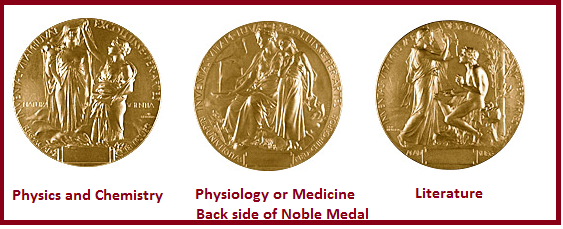
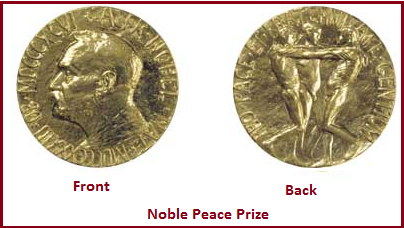
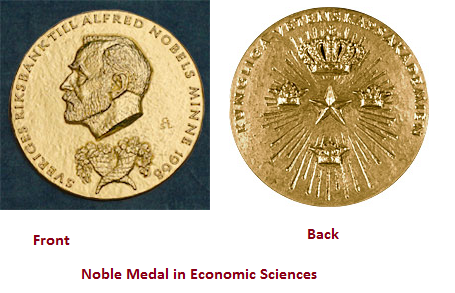
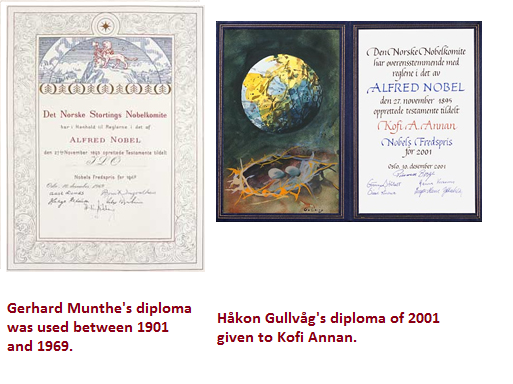
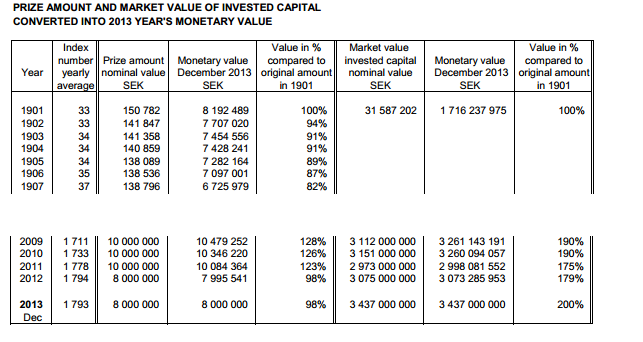




nice post on noble prize…
Thanks for appreciating it.
nice post on noble prize…
Thanks for appreciating it.
Very interesting article.
Just to suggest a small correction:
The word has been mis-spelt at a few places in the article.
It’s the Nob’e’l prize, not the Noble prize.
Thanks KV but I could not find the spelling of Noble prize the way you mentioned it. Even the http://www.nobelprize.org/ spelled Noble as Noble.
Very interesting article.
Just to suggest a small correction:
The word has been mis-spelt at a few places in the article.
It’s the Nob’e’l prize, not the Noble prize.
Thanks KV but I could not find the spelling of Noble prize the way you mentioned it. Even the http://www.nobelprize.org/ spelled Noble as Noble.
What KV meant is that it is spelt as Nobel with the “e” before the “l,” not after it. Check the URL of the site that you have posted…it is spelt as Nobel.
Thanks for feedback.
Updated the article